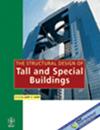典型构型公里级超高层建筑在转向风场中的风荷载CFD模拟
IF 1.3
3区 工程技术
Q3 CONSTRUCTION & BUILDING TECHNOLOGY
引用次数: 0
摘要
大气边界层(ABL)由大气面层(ASL)和Ekman层组成,其总高度约为1 ~ 1.5 km,分别占大气面层的下层10%和上层90%。Ekman层的风转向角可在10°~ 30°之间,这可能是千米级超高层建筑抗风设计的重要影响因素。然而,由于风洞中转向风的模拟和计算流体力学(CFD)模拟平台的困难,目前对这一问题的研究很少。本文对非转向风场和转向风场进行了模拟,并对几种典型结构的公里级超高层建筑在转向风场中的风荷载进行了数值研究。具体而言,系统地进行了三种建筑(方形建筑、锥形建筑(锥度比为6.6%)和相同高度、相同长径比为9:1的4层后退式建筑)在转向风和非转向风条件下的非定常流场大涡模拟。得到了这些建筑物的风压和风力,并进行了综合分析。强调了不同建筑结构的风荷载差异,并基于时间平均流场和瞬时流场讨论了其机理。本文章由计算机程序翻译,如有差异,请以英文原文为准。
CFD simulation of wind loads of kilometer‐scale super tall buildings with typical configurations in veering wind field
Summary The atmospheric boundary layer (ABL), whose total height is about 1–1.5 km, is composed of the atmospheric surface layer (ASL) and the Ekman layer, which typically account for the lower 10% and the upper 90% of the ABL, respectively. The wind veering angle in the Ekman layer can be between 10° and 30°, which may be an important influence factor for the wind‐resistant design of kilometer‐scale super‐tall buildings. Unfortunately, there is very little research on this issue so far due to the difficulty in simulations of veering wind in wind tunnels and computational fluid dynamics (CFD) simulation platforms. In this study, the simulations of non‐veering and veering wind fields are presented, and furthermore, the wind loads of kilometer‐scale super tall buildings with several typical configurations in veering wind fields are numerically investigated. Specifically, the large eddy simulations (LES) of unsteady flow around three buildings, namely, a square building, a tapered building (tapering ratio: 6.6%), and a 4‐layer setback building with the same height and the same aspect ratio of 9:1, are systematically performed for the cases of veering wind and non‐veering wind. The wind pressures and wind forces on these buildings are obtained and comprehensively analyzed. The differences in the wind loads among the building configurations are highlighted, and the mechanisms are discussed based on the time‐averaged and instantaneous flow fields.
求助全文
通过发布文献求助,成功后即可免费获取论文全文。
去求助
来源期刊
CiteScore
5.30
自引率
4.20%
发文量
83
审稿时长
6-12 weeks
期刊介绍:
The Structural Design of Tall and Special Buildings provides structural engineers and contractors with a detailed written presentation of innovative structural engineering and construction practices for tall and special buildings. It also presents applied research on new materials or analysis methods that can directly benefit structural engineers involved in the design of tall and special buildings. The editor''s policy is to maintain a reasonable balance between papers from design engineers and from research workers so that the Journal will be useful to both groups. The problems in this field and their solutions are international in character and require a knowledge of several traditional disciplines and the Journal will reflect this.
The main subject of the Journal is the structural design and construction of tall and special buildings. The basic definition of a tall building, in the context of the Journal audience, is a structure that is equal to or greater than 50 meters (165 feet) in height, or 14 stories or greater. A special building is one with unique architectural or structural characteristics.
However, manuscripts dealing with chimneys, water towers, silos, cooling towers, and pools will generally not be considered for review. The journal will present papers on new innovative structural systems, materials and methods of analysis.

 求助内容:
求助内容: 应助结果提醒方式:
应助结果提醒方式:


